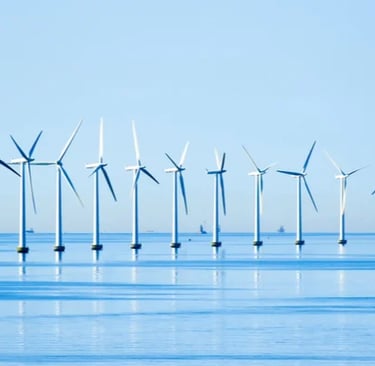Why Sustainability Matters (The Nordic Approach to Climate Change)
Individuals play a crucial role in combatting climate change by adopting sustainable habits and making eco-conscious choices. One of the most effective ways to reduce your carbon footprint is by minimizing energy consumption. Simple actions such as turning off lights when not in use, using energy-efficient appliances, and opting for renewable energy sources can make a significant difference. Additionally, reducing water usage by fixing leaks and using water-saving fixtures contributes to conservation efforts.
THE WORLD AROUND US
Peter
7/12/202410 min read


The Nordic Approach To Climate Change
Climate change adaptation refers to the process of adjusting to actual or expected climate impacts. This involves making informed decisions and implementing strategies to reduce the risks posed by climate change while taking advantage of any potential benefits. As the planet faces rising temperatures, melting ice caps, and increasingly frequent extreme weather events, the importance of climate change adaptation cannot be overstated.
The effects of climate change are widespread and multifaceted, affecting ecosystems, economies, and communities alike. From rising sea levels threatening coastal cities to prolonged droughts impacting agriculture, the urgency for effective adaptation strategies is evident. These strategies are designed to help both natural and human systems cope with environmental changes, thus minimizing damage and fostering resilience.
In a global context, climate change adaptation is a critical component of sustainable development. It ensures that societies can continue to thrive despite the challenges posed by a changing climate. By integrating adaptation measures into planning and development processes, nations can better protect their populations, infrastructure, and natural resources. This proactive approach not only mitigates the adverse effects of climate change but also enhances the capacity to respond to future climatic shifts.
Scandinavia, with its unique geographical and climatic characteristics, faces specific climate-related challenges. The region is already experiencing notable changes, such as increased precipitation, warmer temperatures, and shifts in ecosystems. These transformations necessitate targeted adaptation strategies tailored to the Nordic environment. As the blog post progresses, we will delve into how Scandinavian countries are addressing these challenges through innovative and effective climate adaptation measures.
Understanding climate change adaptation and its significance lays the foundation for exploring the various approaches and actions being undertaken globally and locally. With a comprehensive grasp of the concept, we can better appreciate the efforts made by the Nordic countries and individuals in combating the impacts of climate change.
Welcome to Scandi Home Heaven! We believe in transparency and want to disclose that some of the links on our site are affiliate links. This means that at no additional cost to you, we may earn a commission if you click through and make a purchase. We only recommend products and services we have personally used and believe will add value to our readers.
Your support helps us continue to provide high-quality content. Thank you!
The Impact of Climate Change on Scandinavia
Climate change is exerting significant impacts on Scandinavia, manifesting through various environmental and socio-economic challenges. One of the most evident effects is the rise in temperatures across the region. Scandinavia has experienced a marked increase in average temperatures, a trend that is projected to continue. This warming has led to alterations in precipitation patterns, with some areas receiving more intense rainfall, while others face prolonged dry periods. These changes in weather patterns contribute to an increased frequency of extreme weather events such as storms, floods, and heatwaves.
The natural ecosystems of Scandinavia are also under considerable stress due to climate change. The region's flora and fauna are facing habitat shifts and disruptions in their life cycles. For instance, certain plant species are blooming earlier than usual, while some animal species are migrating to new areas or facing population declines. These ecological changes have cascading effects on biodiversity, threatening the balance of these delicate ecosystems.
Socio-economically, industries such as agriculture, forestry, and fisheries are feeling the brunt of climate change. Agricultural practices are being challenged by unpredictable weather, affecting crop yields and farming schedules. The forestry sector is grappling with increased risks of pest infestations and forest fires, while fisheries are affected by changing sea temperatures and acidification, which impact fish populations and marine biodiversity.
Coastal communities in Scandinavia face unique challenges due to rising sea levels. These communities are at an increased risk of flooding and coastal erosion, which threaten infrastructure, homes, and livelihoods. Efforts to adapt to these changes are essential to mitigate the adverse effects and to protect the socio-economic well-being of these vulnerable populations.
In summary, the impact of climate change on Scandinavia is multifaceted, affecting the environment, economy, and communities. Addressing these challenges requires a comprehensive approach, integrating scientific research, policy measures, and community engagement to foster resilience and sustainable adaptation strategies.
Government Initiatives in Nordic Countries
The Nordic countries have been at the forefront of climate change adaptation and mitigation, implementing a range of robust initiatives and policies designed to address environmental challenges. National and regional strategies across these countries emphasize investments in renewable energy, stringent carbon reduction targets, and sustainable urban planning, all aimed at fostering resilience against climate change impacts.
In Sweden, for example, the government has committed to achieving net-zero greenhouse gas emissions by 2045. This ambitious target is supported by substantial investments in wind and solar energy projects, as well as innovative technologies like carbon capture and storage (CCS). Similarly, Norway leverages its vast hydroelectric resources to generate clean energy, with over 95% of its electricity coming from renewable sources. The country also aims to reduce emissions by 50-55% by 2030 compared to 1990 levels.
Denmark's Energy Agreement of 2018 sets a path for the country to reach 100% renewable electricity by 2030. This is complemented by significant investments in offshore wind farms, which position Denmark as a global leader in wind energy. Finland, on the other hand, focuses on sustainable forestry practices and bioenergy, striving to become carbon neutral by 2035. Iceland, renowned for its geothermal energy, continues to expand its renewable energy capacity while also tackling emissions from transportation and heavy industry. Today, more than half of Denmark's electricity production comes from wind farms. The number of active wind turbines is increasing yearly and reached a value of 6,296 installations at the beginning of 2022, achieving a production capacity of approximately seven gigawatts. (10 Jan 2024)
Collaboration among Nordic countries plays a vital role in their climate strategies. The Nordic Council of Ministers fosters joint initiatives and knowledge sharing, ensuring a cohesive approach to climate adaptation. These countries also actively participate in international climate agreements, such as the Paris Agreement, demonstrating their commitment to global climate goals.
Several successful projects underscore the proactive stance of Nordic governments. For instance, the Nordic Green Building Councils promote sustainable construction practices, while the Carbon Neutral Cities Alliance (CNCA) helps cities like Oslo and Helsinki implement comprehensive climate action plans. These examples highlight the region's dedication to addressing climate change through innovative and collaborative efforts.
Community and Grassroots Efforts
In the realm of climate change adaptation, the role of communities and grassroots organizations in Scandinavia cannot be overstated. These local entities are at the forefront of initiating and driving sustainable change through a multitude of innovative approaches and community-based projects. One significant area where communities have made substantial strides is in the development of renewable energy projects. For example, in Denmark, the establishment of community wind farms has not only reduced carbon emissions but also empowered local residents to take ownership of their energy resources.
Conservation efforts are another crucial facet of grassroots involvement. Across Scandinavia, local groups have been instrumental in preserving natural habitats and promoting biodiversity. In Sweden, various community-led initiatives have focused on reforestation and wetland restoration, which play essential roles in carbon sequestration and flood mitigation. These efforts often involve collaborative partnerships between residents, local governments, and environmental organizations, thereby reinforcing the importance of civic engagement in achieving climate resilience.
Awareness campaigns led by grassroots organizations also play a pivotal role in fostering a culture of sustainability. In Norway, community groups have launched educational programs aimed at reducing waste and promoting recycling. These campaigns have successfully influenced public behavior by highlighting the long-term benefits of sustainable practices. Additionally, awareness initiatives often serve as a platform for advocating policy changes that support environmental conservation and climate adaptation.
The impact of collective action in driving sustainable change is exemplified through various case studies of successful community-led projects. For instance, the community of Samsø in Denmark has transformed itself into a carbon-neutral island through a combination of renewable energy installations, energy efficiency measures, and sustainable agricultural practices. Similarly, the city of Umeå in Sweden has implemented a comprehensive climate action plan that includes community consultations and participatory decision-making processes.
These examples underscore the critical role that communities and grassroots organizations play in climate change adaptation. Their efforts not only contribute to local sustainability but also serve as scalable models that can inspire and educate other regions globally. By fostering a sense of collective responsibility and engagement, these grassroots initiatives exemplify the power of community in addressing the pressing challenges of climate change.
Individual Actions to Mitigate Climate Change
Individuals play a crucial role in combatting climate change by adopting sustainable habits and making eco-conscious choices. One of the most effective ways to reduce your carbon footprint is by minimizing energy consumption. Simple actions such as turning off lights when not in use, using energy-efficient appliances, and opting for renewable energy sources can make a significant difference. Additionally, reducing water usage by fixing leaks and using water-saving fixtures contributes to conservation efforts.
Transportation is another critical area where individuals can impact climate change. Opting for public transportation, carpooling, biking, or walking instead of driving alone reduces greenhouse gas emissions. For those who drive, choosing fuel-efficient or electric vehicles can also contribute to lower carbon emissions. Moreover, reducing air travel and opting for virtual meetings when possible can significantly cut down on carbon footprints.
Sustainable consumption habits are essential for mitigating climate change. Supporting local and seasonal produce reduces the carbon footprint associated with food transportation. Reducing meat and dairy consumption, known as "eating lower on the food chain," can also lower greenhouse gas emissions. Additionally, minimizing food waste by planning meals and composting organic waste are effective strategies.
Individuals can further support climate change mitigation by purchasing eco-friendly products and services. Choosing products with minimal packaging, made from sustainable materials, and produced by companies with strong environmental practices can drive demand for greener alternatives. Supporting businesses that prioritize sustainability encourages more companies to adopt eco-friendly practices.
Personal responsibility extends beyond daily habits to include advocating for broader policy changes. Engaging with local, national, and international environmental organizations, participating in climate action campaigns, and voting for leaders who prioritize climate policies are powerful ways to influence systemic change. By raising awareness and supporting environmental causes, individuals can amplify their impact.
The cumulative effect of individual actions can create significant positive change. By adopting sustainable habits, supporting eco-friendly products, and advocating for environmental policies, each person can contribute to a collective effort that mitigates climate change and fosters a more sustainable future.
Future Prospects and Conclusion
As we look to the future, climate change adaptation in Scandinavia is poised to leverage emerging trends and technological innovations. The Nordic countries have consistently been at the forefront of environmental sustainability, and their proactive stance on climate change is no exception. Cutting-edge technologies such as carbon capture and storage (CCS) and advancements in renewable energy sources like wind and solar power are expected to play critical roles in reducing greenhouse gas emissions. Moreover, the integration of smart grid technologies is set to enhance energy efficiency and reliability, further bolstering Scandinavia's resilience against climate change.
However, the future is not without its challenges. One significant hurdle is the need for substantial investment in infrastructure to support these technological advancements. Additionally, the unpredictable nature of climate change impacts requires ongoing research and flexible adaptation strategies. As temperature extremes, sea-level rise, and changing precipitation patterns continue to pose threats, the Nordic countries must remain vigilant and adaptive.
Throughout this blog post, we have explored various facets of climate change adaptation in Scandinavia, from governmental policies and community involvement to individual actions. The importance of a multi-faceted approach cannot be overstated. Government policies provide the framework and resources necessary for large-scale initiatives, while community involvement ensures that local needs and knowledge are incorporated into adaptation plans. On an individual level, daily habits and lifestyle choices significantly contribute to the collective effort to combat climate change.
In conclusion, addressing climate change requires a concerted effort from all sectors of society. The Nordic approach, characterized by innovation, collaboration, and proactive policies, offers valuable insights and serves as a model for global efforts. As we move forward, it is imperative that we harness the power of technology, invest in sustainable infrastructure, and foster a community-driven approach to adaptation. By doing so, we can build a resilient future and empower individuals to take meaningful action in their own lives and communities.
Welcome to my Designs
Welcome to a world of creative expression! Based in the heart of Copenhagen but reaching customers worldwide, I bring over 500 unique designs to life on t-shirts, hoodies, mugs, and more. Passionate about graphic design, I combine Nordic inspiration with global appeal to offer stylish, high-quality merchandise through Shopify/Printify and Teepublic. Whether you’re looking for a cozy sweatshirt or a personalized candle, each product is crafted to make everyday moments extraordinary.
Explore, express, and enjoy!
Welcome to my world of creative expression! Based in the heart of Copenhagen but reaching customers worldwide, I bring over 500 unique designs to life on t-shirts, hoodies, mugs, and more. Passionate about graphic design, I combine Nordic inspiration with global appeal to offer stylish, high-quality merchandise through Shopify/Printify and Teepublic. Whether you’re looking for a cozy sweatshirt or a personalized Coffee Mug, each product is crafted to make everyday moments extraordinary.
Explore, express, and enjoy!
Advertisment for our Merchndise Shop














